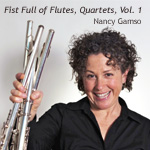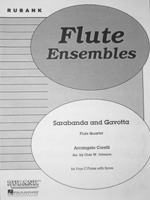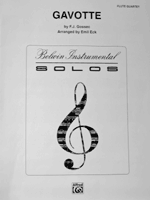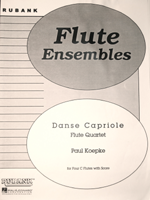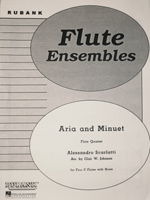Fist Full of Flutes, Quartets, Vol. 1
These quartets for four C flutes are appropriate for intermediate flutists and also work well for casual classical gigs, sight-reading and adult amateurs. All are published alone and range in style from Baroque (Scarlatti, Corelli), Neo-Romantic and Neo-Classical (Gossec, Koepke). Complete publishing information can be found below.
Tracks for each piece below are available separately as high-quality mp3 files.
Or, download the entire set (single zip file): Flute-Quartets-Vol.-1
Corelli, Archangelo; Johnson, Clair W., arranger; Sarabanda and Gavotta, Rubank, 2054-3
Composer Highlights
Archangelo Corelli (1653-1713) When we study Corelli we find a composer, teacher and music director who made a virtue of discipline when it came to teaching his violin students and ensembles – so much so that his techniques provided the model for other teachers. He also made an entire career as a composer writing only instrumental music and only in the forms of solo sonatas, trio sonatas and concertos.The research trail for this arrangement led to a publication of the Complete Violin Sonatas and Trio Sonatas, edited by Joseph Joachim and Friedrich Chrysander, Dover Scores (thanks to OhioLink and Case Western Reserve Kelvin Smith Library). Corelli’s Op. 5 are miscellaneous works, officially titled Preludes, Allemandes, Correntes, Gigues, Sarabandes, Gavottes and Follia, Op. 5, Part 2, published in 1700 and dedicated to Electress Sophie Charlotte of Brandenburg. These two movements are from two different sonatas in this collection. The Sarabande comes from Sonata VII, Op. 5, Part 2 and the Gavotta is found in Sonata X, Op. 5, Part 2. By the way, do you know that “follia” (also spelled “folia”) are early 18th century chord progressions over which musicians improvised, very similar to our blues progression? All of the follia in this collection have the same chord progression as described in the Wikipedia article for “later folia”. I see some Corelli-jazz fusion in my future.
Practice Suggestions
Sarabanda: I love, love, love improvising ornamentations on slow Baroque melodies, so as you listen to this, I hope it inspires you to try it yourself. Here’s how:Step 1 - Get to know the music very well without the ornamentation. This is to assure that when you are comfortable with the music you can add the ornaments without disturbing the core rhythm and melodic line.
Step 2 - Listen to some model recordings of flute players ornamenting Baroque slow melodies. I cut my teeth listening to Rampal’s recordings of the Handel Sonatas (on vinyl!) over and over, so my repertoire of 18th century ornament vocabulary was ingrained in my musical brain. For Corelli, I found “Corelli: Sonatas for Strings” by Robert Woolley, Jakob Lindberg and the Purcell Quartet to be excellent.
Step 3 - Just experiment on your own. You can always transcribe my ornaments but you may have even more fabulous ones, so try a few different ones to see what sounds good to you.
Step 4 - Make sure your notes work with the chord underneath. If you have a pretty good musical ear, it will tell you what sounds right but you can also look at the chord under the melody for what notes will work. For example, there is a G7 in m. 9, so adding a b-natural is correct, since a G dominant 7 chord is spelled G-B-D-F.
The only other thing is to make sure your ornaments and trills are S.O.P. (my flute teacher at FSU, Charlie Delaney and the U.S. Army’s acronym for Standard Operating Procedure). That means, the ornaments are added on the 2nd time through the repeated sections and start the trills from above. Since the 1st player is having all the fun, you might try to switch parts at the repeats and let everyone have a chance to play the ornamentation.
The other considerations for this movement are soon quite obvious. They include intonation, deciding which breaths you need and which you don’t in order to phrase together, dynamics, note lengths, and the ritardando at the end. There will be a few short videos on some of these topics that may help, such as the Tuning video, so check them out.
Gavotta: This movement is spritely and perfect for flute players – we can so do spritely. I added a mezzo-piano at the pick up to m. 9 and changed the piano in the 3rd part at pick up to m. 13 to a mezzo-forte in order to bring out the melody. I added a downward mordent at the end in the 1st part, just for fun and because it was a common ending ornament for the style. Speaking of the ending, don’t you love the “and many more” tag in the 3rd part? I would have liked to have known Corelli, he has me weeping on the Adagio (flute trio) and laughing out loud on this one.
Download Tracks
01-Corelli, Sarabanda, complete version
02-Corelli, Sarabanda, minus 1st part
03-Corelli, Sarabanda, minus 2nd part
04-Corelli, Sarabanda, minus 3rd part
05-Corelli, Sarabanda, minus 4th part
06-Corelli, Gavotta, complete version
07-Corelli, Gavotta, minus 1st part
08-Corelli, Gavotta, minus 2nd part
10-Corelli, Gavotta, minus 4th part
09-Corelli, Gavotta, minus 3rd part
Download all ten tracks (single zip file)
Gossec, F. J.; Eck, Emil, arranger; Gavotte, Belwin-Mills/Alfred, ENS00116
Composer Highlights
François Joseph Gossec (1734-1829), a French composer, managed to leave us the one famous tune – famous in the U.S. because Carl Stalling, composer/arranger for Loonie Tunes, loved using this Gavotte when Bugs Bunny, Elmer Fudd or any of the other characters were dancing the ballet. For those sophisticates out there who were Suzuki kids, you know this tune from your studies. In any case, Monsieur Gossec did love to compose: for opera, for the church, for chamber musicians and for his own orchestra (in his own concert series called Concert des Amateurs, as in ‘concerts for lovers of music’). He once had a band of clarinets, trumpets, horns, trombones, and eight bassoons placed in a balcony for a requiem mass just to illustrate the verse: “The trumpet, scattering a wondrous sound, through the sepulchers of the regions, will summon all before the throne”. Now that’s some liturgical show biz! I noticed that Gossec also had many marches and other music for wind band in his repertoire and found that he was actually the director of the Corps de Musique de la Garde Nationale at the beginning of the French Revolution. The purpose of the garde and the other musical groups in France at the time, was to stir up the common folk in support of the revolution. If you want to read more about Gossec and his wind band army, check out this online source for wind band history.The Gavotte is often arranged for piano. It’s not clear for what the work originally was intended, perhaps the manuscript listed in his works as the Gavotte in D for flute and string quartet. Here’s the link to the piano score.
Practice Suggestions
Download Tracks
11-Gossec, Gavotte, complete version
12-Gossec, Gavotte, minus 1st part
13-Gossec, Gavotte, minus 2nd part
14-Gossec, Gavotte, minus 3rd part
15-Gossec, Gavotte, minus 4th part
Download all five tracks (single zip file)
Koepke, Paul; Danse Capriole, Rubank/Hal Leonard, HL04479506
Composer Highlights
Practice Suggestions
Download Tracks
16-Koepke, Danse Capriole, complete version
17-Koepke, Danse Capriole, minus 1st part
18-Koepke, Danse Capriole, minus 2nd part
19-Koepke, Danse Capriole, minus 3rd part
20-Koepke, Danse Capriole, minus 4th part
Download all five tracks (single zip file)
Scarlatti, Alessandro; Johnson, Clair W., arranger; Aria and Minuet, Rubank/Hal Leonard, HL04479502
Composer Highlights
Practice Suggestions
For the Aria, I thought I would leave this recording unornamented (see the Corelli Sarabanda for a lengthy discussion on Baroque ornamentation). The reason for this is both pedagogical – I wanted a simpler version for students – and musical – the 1st and 2nd parts are so closely tied rhythmically that it is perhaps better to leave them both plain. However, cadential trills (trills on the long notes before cadence chords) can be easily added in the 1st part. You may notice that I omitted the breaths at mm. 2, 5, 10 and 21, and as well, moved the breath mark in m. 12 to after the half note and in the 2nd part, m. 15, to before the ‘f-sharps’. All the cadences are great opportunities to learn good intonation. On the unison ‘g’ I chose to take out the vibrato, as an effective way to capture one aspect of the 17th century style.In the Minuet, I was most interested in getting the staccato notes to sound full and crisp but not heavy. Then, in the measures with more lyrical lines, I intended to make the notes graceful and connected. My favorite spot in this one is mm. 17 -18, where the 4th and 3rd parts hand off the eighth-note bass line. Listen to see if you can make it sound like one player.
Download Tracks
21-Scarlatti, Aria, complete version
22-Scarlatti, Aria, minus 1st part
23-Scarlatti, Aria, minus 2nd part
24-Scarlatti, Aria, minus 3rd part
25-Scarlatti, Aria, minus 4th part
26-Scarlatti, Minuet, complete version
27-Scarlatti, Minuet, minus 1st part
28-Scarlatti, Minuet, minus 2nd part
29-Scarlatti, Minuet, minus 3rd part
30-Scarlatti, Minuet, minus 4th part
Download all ten tracks (single zip file)

